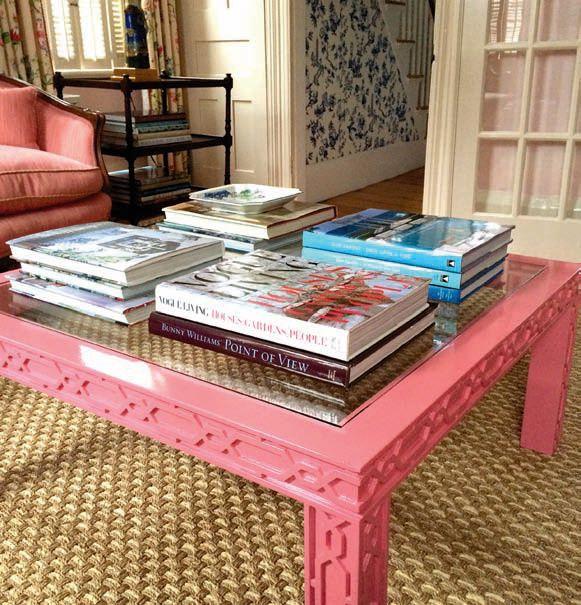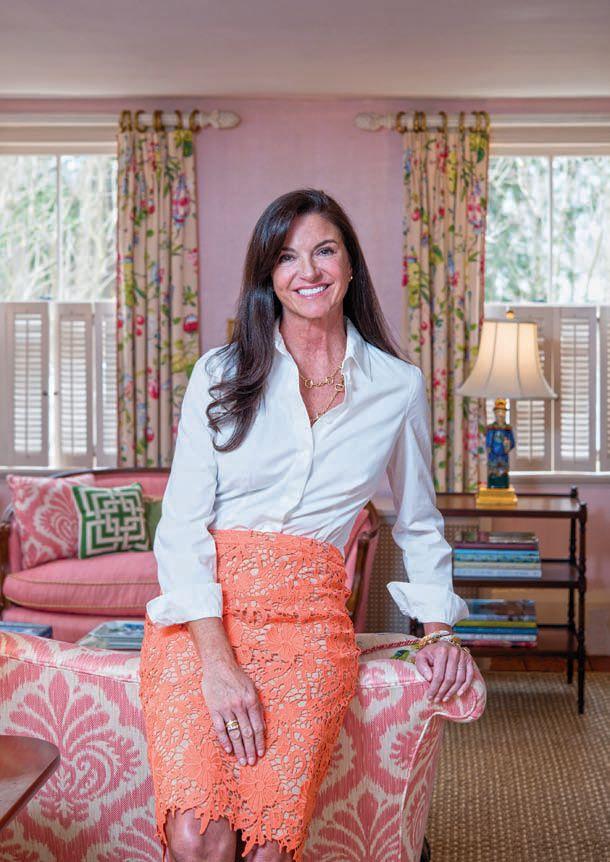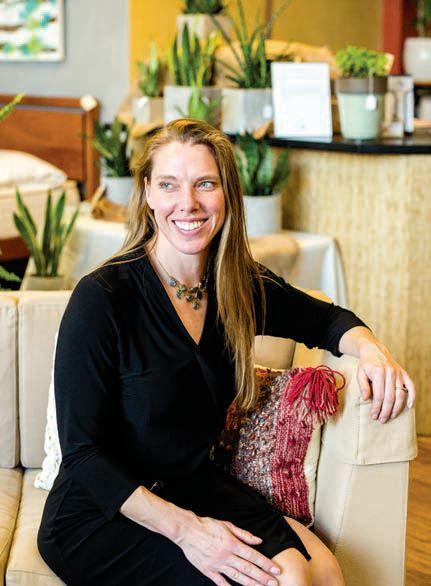
13 minute read
The Business of Sustainability
BY SOPHIA BENNETT
In October 2018, the United Nations’ Intergovernmental Panel on Climate Change issued a report saying that nations needed to significantly lower their carbon emissions by 2030 or face dire, irreversible consequences. The warning hit home for millions of people who were beginning to clearly see the signs of a changing planet, including stronger storms, flooding, longer droughts and mass dieoffs of birds and other animals.
“We are in a critical situation with climate change,” says Susan Inglis, executive director of the Sustainable Furnishings Council (SFC). “Really and truly, we all—individuals, designers, industry sectors—need to take radical action and do what we can to address the problems that are causing these dramatic changes to our climate."
“Consumers are more and more concerned about sustainability issues and they’re acting out of their concern,” she adds. SFC regularly surveys consumers to better understand their thoughts about environmental sustainability in general and green furnishings more specifically. In its 2017 study, 80 percent reported feeling heightened concern about environmental issues. Nearly 90 percent pledged to vote for political candidates who would support earth-friendly legislation.
Most respondents had already acted on their concerns by making lifestyle changes. These included replacing light bulbs with more energy-efficient varieties, buying fewer plastic water bottles and investing in green goods such as cleaning supplies and paper products. “They’re not buying a lot of eco-friendly home furnishings relative to other things that cost a lot, such as cars and energy-efficient appliances,” says Inglis. “When we ask why, they say, ‘Is there such a thing?’”
That’s where your business can come in. SFC’s study found that 90 percent of consumers are interested or very interested in buying green home furnishings if style and price are comparable. About half say they’d pay 5 to 10 percent more for eco-friendly home products. There’s also a subset who are willing to invest a higher amount because they’re committed to keeping their impact on the environment low. If you can help these people realize that affordable, beautiful, environmentally friendly home products are easier to find than they’ve ever been, you can be their hero.
Nikki MacCallum, owner of Nikki Designs in Victoria, BC, specializes in making custom window coverings and other home décor products with natural and organic fabric. That focus has had a positive impact on her company. “It’s always good to have a niche market in your business,” she says. “Specializing in this has separated me from my competition.” She also feels better about working with fabrics that are healthier for her customers and don’t cause harm to farmers and their workers.
Here’s what you need to know to educate consumers on the many ways window coverings and other home products can help them accomplish their eco-friendly goals—and hopefully grow your client base at the same time.
Nikki MacCallum

Nikki MacCallum

Going Green, Saving Green with EnergyEfficient Window Coverings
One of the most compelling reasons to go green is that it can save you money over time. Make sure clients understand the link between window fashions, energy efficiency and maintaining a comfortable living environment.
“Window treatments have the ability to control air loss and thermal exchange of heat,” says Karen Totino, owner of Green Conscience Home & Garden, an interior design showroom in Saratoga Springs, NY, that specializes in creating healthy environments. When it’s hot outside, closing the blinds or shutters will keep out the beating sun, which reduces the need to run the air conditioner.
Coach clients to keep their window coverings closed when the sun isn’t shining during the winter months, and open them when it is. Even in the winter, those solar rays can help warm the interior and keep the house cozy.
All of these actions reduce the load on the HVAC system, which will save the homeowner money. Saving energy is also good for the environment because the majority of our electricity still comes from fossil fuels.
Inglis says she often recommends window films in desert and tropical locales where sunlight is always intense. “I would not recommend that in a place where you want the sun in the winter months,” she says, because you risk losing that passive solar gain.

Healthy Is the New Green
If you’re struggling to get clients on board with your green message, try approaching the issue from another angle. Personal health is something everyone from millennials to baby boomers is thinking about right now. And, even though people don’t always realize it, being healthy and being green are linked because both require consuming products with fewer toxins.
Totino argues that “healthy” is the new green. “People see the value in switching to organic foods because our foods have been sprayed with chemicals that we ingest into our body,” she says. “They see the value of switching their personal-care products, that we absorb the chemicals in them through our skin. What they don’t think about is pollutants we absorb through breathing.” Unfortunately, those pollutants can be significant. Data from the U.S. Environmental Protection Agency shows that the air inside a home can be two to five times more polluted than the air we breathe outside. One of the major things that influences indoor air quality is fabrics, furnishings and finishes. Furniture made with pressboard, particleboard and other engineered wood products is often loaded with chemicals. Paint, varnish, glue and anything else that goes from a liquid to solid state can contain loads of volatile organic compounds (VOCs). Textiles can be treated with a number of chemicals, including formaldehyde and fire retardants.
The immediate symptoms caused by these chemicals can be significant. Many people experience burning eyes, brain fog and headaches. Over the long term, exposure to VOCs can affect the body on a deeper level, leading to serious illnesses, chronic diseases and fertility issues. The impact on children can be even greater because their bodies are small and still developing. “When you start picturing your baby sleeping on a sheet with all kinds of chemicals that can cause breathing problems, that makes it real for people,” says MacCallum.
A growing number of people are developing such extreme chemical sensitivities that they can’t be exposed to any chemicals without becoming quite sick. These individuals often struggle to find products they can have in their home, which makes them a great market for designers who specialize in using healthy and ecofriendly fabrics and other products.
But the market is growing in general just because more people are concerned about the adverse effects of poor indoor air quality. Be sure to mention the health benefits of going green to consumers who are already looking for sustainable home products. It will give them another reason to invest in your eco-friendly window treatments.
Material Differences
One of the biggest things designers can do to go green is switch up the materials they’re using. “For any consumer product, whether it’s a curtain or a coat, the largest part of the environmental impact or footprint is in the materials,” says Inglis. “Choosing less energy-intensive materials will save energy.”
Fabrics that fall into the green category include organic cotton, linen, silk, wool and anything else made with natural fibers. Wool has the added benefit of being naturally fire-resistant. When possible, look for fabrics certified by a third-party body such as the Global Organic Textile Standard or OEKO-TEX. (See sidebar for information about these certification programs and more.)
Even though cotton is a natural material, it’s important to look for organic varieties if your goal is to deliver a truly sustainable (and healthy) product. “Regular cotton needs so many pesticides and chemicals to grow the crop,” says MacCallum. “They leech into the soil and water and they stay in the fabric. Many fabrics, including cotton, have dyes, bleach, fabric softeners and formaldehyde.”
“As a rule of thumb, natural materials take less energy than synthetic materials,” Inglis says. “Of course, if the natural material—cotton being our favorite—is organically grown, it takes significantly less energy. Fertilizers and agricultural chemicals contribute dramatically to greenhouse gas emissions.”
“Thirteen years ago it was really a struggle to find organic fabrics,” says MacCallum. “It’s much easier now.” As demand has increased, so has competition among manufacturers and suppliers, which is driving down prices. (See sidebar for a list of eco-friendly fabric and blind providers.)
Designers might also consider using wooden blinds, louvers and shutters instead of ones made from vinyl or other synthetic materials. But not all wood is created equally. “Forests are so important to addressing the problems of climate change and pollution,” says Inglis. That’s because large forests, especially those located near the equator, absorb the carbon we need to keep out of the atmosphere.
“If you’ve got a forest, leave it a forest,” says Inglis. “That does mean choosing wood products carefully. Choosing wood you know is legally logged from well-managed forests assures you that it will grow back at a reasonable pace.” She recommends looking for wood products that are certified by the Forest Stewardship Council.


Meg Hosler. Photo by Mary Prince
Upcycling, Recycling and More
Remember the adage “reduce, reuse, recycle”? It’s not a coincidence that the words were listed in that order. The best thing anyone can do for the environment is reduce their consumption. When you buy less, you consume fewer raw resources and put less energy into making things. That keeps your carbon footprint much lower.
“Buy less” sounds counterintuitive to a designer’s message, but that’s where reuse can come in. Incorporating antiques, DIY projects made from upcycled materials, and a client’s collected items and treasured keepsakes into spaces is incredibly trendy right now. When you source and arrange these materials for clients, you’ll help them end up with a space they truly love, which can lead to more referrals. Plus, everyone can feel good about diverting things that might have ended up in a landfill or incinerator.
Meg Hosler of Meggie H. Interiors in Wenham, MA, says another reason to consider reused items is that they’ll last and look good for a longer period of time. “Sure, those funky contemporary cabinets look chic today, but how fashionable will they look 10 years from now? Traditional, classic style never goes out of date. This is something to consider, not just from a cost perspective, but from an environmental one as well.”
Folks who are on a budget will appreciate designers who help them find ways to utilize what they already have instead of buying everything new. “Can that [sofa or chair] be slipcovered or reupholstered as opposed to purchasing a new piece?” asks Hosler. “How about looking to your attic for those wide pine floors to be used in your new addition rather than having more trees cut down? Old kitchen cabinets are great to hang in your basement or garage for storage. Maybe that old piece of furniture can be painted to give it a fresh look.”
Hosler’s final piece of advice is to consider donating unwanted furniture and building materials that are in good shape to a charity. The homeowner may be able to get a tax write-off, and their waste will be put to good use rather than going into a landfill. Habitat for Humanity has ReStore locations across the country that need unwanted building supplies. Look for a resource online or visit the Building Materials Reuse Association (bmra.org) to see if they have a member organization near you.
Green vs. Greenwashed
As more consumers have started looking for sustainable products, “greenwashing,” or claiming a product is eco-friendly when it really isn’t, has gotten a lot more common. One way to make sure a product is truly green is to look for a third-party certification. (See the sidebar for a partial list of green certification programs for home products.)
But that’s not the only way to avoid greenwashing—or even the best way, in some circumstances. Totino works with several small companies that can’t afford to pay for the certification. In those cases, you have to do some due diligence, she says. It’s often a smart idea to look more into a company’s claims about their products anyway.
“Sometimes a company will say a product is sustainable or environmentally friendly because they’re using recycled content or bamboo, which is fast growing and saves hardwoods. But [in the case of flooring] they add formaldehyde, so it’s not safe to bring into your home.”
If a company claims their product is green, spend some time exploring their website to determine what makes it green. Or call the company and ask them directly. It may also be helpful to develop a list of green priorities to use when evaluating products. Green can mean many things: using products that will not offgas, contain recycled materials, are recyclable at the end of their life cycle or are sustainably sourced. It may not be possible to get all of those things in one product, which means you have to prioritize based on your values or those held by your client.
“Most small businesses now really do tell a story about why and how they operate,” MacCallum says. “They’re open and honest about who they are and why they do what they do. I find they are [creating environmentally sound products] because they do care.” As your care and concern for the environment and all of these related issues grows, use that to your advantage. z
Karen Totino

Green Product Certification Programs
Buying products that are third-party certified as ecofriendly is a good way to ensure you’re purchasing supplies that are easier on the environment. Here are some of the certification programs that exist for home and interior products.
Forest Stewardship Council
Forest Stewardship Council certification ensures that products come from responsibly managed forests that provide environmental, social and economic benefits. us.fsc.org
Global Organic Textile Standard
An internationally recognized certification program for textiles. Certified textiles must contain a minimum of 70 percent recycled fiber. Certifiers also look at things like the toxicity of dyes and other chemical inputs and how wastewater from processing plants is handled. global-standard.org/public-database.html
GreenGuard
GreenGuard certification is available for products that meet some of the world's most rigorous and comprehensive standards for low emissions of volatile organic compounds. greenguard.org/en/
architectsDesigners.aspx
OEKO-TEX
The Standard 100 by OEKO-TEX is a worldwide, independent testing and certification system for raw, semifinished and finished textile products and accessory materials. oeko-tex.com
Upgrade Your Eco-Knowledge with GREENleaders
Window fashion professionals interested in learning more about sustainable design can participate in the Sustainable Furnishings Council’s GREENleaders program. This six-hour certificate course is offered online or in person three times a year. It includes basic education on current environmental issues, consumer insights and tips for sourcing green products. “It also includes a sales training module so you can put all of this together and grow your business,” says Inglis. Get more information at sustainablefurnishings.org.
Companies Offering Green Fabrics and Blinds
Our green designers recommend the following companies for eco-friendly products:
Canadian Blind Manufacturing cdnblind.com
Earth Shade earthshade.com
EnviroTextiles envirotextile.com
Habitat Blinds and Shading Systems habitatblinds.com
Hemp Traders hemptraders.com/Hemp-Textiles-s/1817.htm

HAND-CRAFTED EXCELLENCE






Watch the video at sarkisstudio.com the video at sarkisstudio.com/story/story














